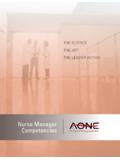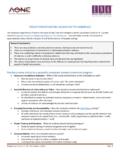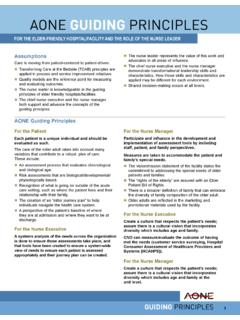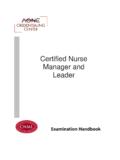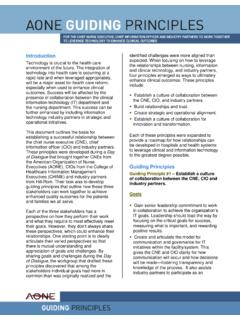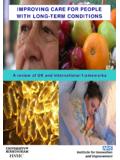Transcription of AONE Nurse Executive Competencies: Population Health
1 COMMUNICATIONKNOWLEDGELEADERSHIPPROFESSI ONALISMBUSINESS SKILLSN urse Executive competencies : Population Health2 AONE Nurse Executive competencies : Population Health 2015 The American Organization of Nurse Executives Suggested APA Citation: American Organization of Nurse Executives. (2015). AONE Nurse Executive competencies : Population Health . Chicago, IL: Author. Accessed at: at: : or 312-422-2800 2015 American Organization of Nurse Executives (AONE). All materials contained in this publication are available to anyone for download on , for personal, non-commercial use only. No part of this publication may be reproduced and distributed in any form without permission of AONE, except in the case of brief quotations followed by the above suggested citation.
2 To request permission to reproduce this material, please email AONE Nurse Executive competencies : Population Health 2015 The American Organization of Nurse Executives Health care systems increasingly are identifying strategies and interventions to improve the Health of their patients and the communities they serve. Acute, ambulatory and post-acute care organizations are realizing the promotion of Health and wellness outside their settings creates improved outcomes. This shift in care delivery focuses on partnerships across the Health care settings and addressing specific Health needs of particular populations. Population Health management (PHM) programs seeks to improve the Health outcomes of entire populations through the effective utilization of patient data and analyzing that data into actionable efforts that lead to improved clinical and financial outcomes.
3 Tantamount to the development, execution, and refinement of PHM programs is leadership from the Nurse Executive . As an advocate for community Health needs and patient populations, the Nurse Executive serves as an agent of change in this strategic effort. OVERVIEWR eliability and validity for the AONE Nurse Executive competencies is established by periodic job analysis/role delineation studies. These competencies are based on A National Practice Analysis Study of the Nurse Executive (2014).ASSUMPTIONS Health care systems will consolidate and become a predominant model of integrated care delivery. The Health care enterprise will be patient centric. Enterprise-focused Executive nursing leadership is essential to the success of integrated delivery networks.
4 Nursing practice must be aligned to the future state of integrated delivery. Academic practice partnerships are critical to current and future workforce development. Hospital will not be centric to care delivery; the Health care continuum will be the focus. Interprofessional collaboration is critical to future state. Legislation, policy and regulation should be guiding principles aligned with effective care delivery systems. The shift to Population Health management will continue. Value-based purchasing will decrease Health care costs through efficiencies across the integrated delivery networks. The pressure for standardization based on sound evidence based practice will continue. Health care system transformation will continue to evolve.
5 Population Health Management is the foundation for value-based reimbursement. competencies for Nurse executives to lead Population Health Management initiatives are requisite educational preparation in current and future Health care delivery AONE Nurse Executive competencies : Population Health 2015 The American Organization of Nurse Executives A. EFFECTIVE COMMUNICATION Produce and present cogent and persuasive communication materials to address Population Health issues appropriate to diverse audiences with the outcome of engaging people, communities and organizations. Effectively resolve and manage conflict with direct reports and colleagues. Possess excellent negotiation skills related to contracts and programs. Competently navigate of social media to ensure effective communication across a wide audience.
6 B. RELATIONSHIP MANAGEMENT Build trusting, collaborative relationships with stakeholders that demonstrate interprofessional partnerships across the continuum of care, practice settings and the community. Include the integration of virtual technologies where appropriate. Facilitate direct and honest interactions in a credible and supportive manner. Demonstrate integrity, including follow-through on promises and concerns. Provide service recovery to dissatisfied stakeholders. Demonstrate empathy and concern for individuals and groups while ensuring that organizational goals and objectives are met. Assert views in non-threatening, non-judgmental ways. Build relationships with communities, organizations and Health care providers to provide smooth transitions throughout the continuum of care and within Population served.
7 Acknowledge and celebrate successes and accomplishments of the INFLUENCING BEHAVIORS Collaborate with stakeholders to create and communicate a shared vision related to Population Health . Collaborate with stakeholders to develop, communicate and monitor behavior expectations. Demonstrate confidence and boldness in addressing sensitive or emotional issues. Provide feedback and mentoring to new leaders, including DIVERSITY Create an environment which recognizes and values differences in staff, Health care providers, patients, families and the community at large. Assess current environment and establish indicators of progress toward cultural competency. Define diversity as understood by stakeholders, patients, families and communities. Incorporate Population data to identify cultural clusters within communities and engage patients and families in assessing needs, defining and implementing solutions, and evaluating outcomes.
8 Define cultural competency and permeate principles and expectations throughout the organization. Address inappropriate behaviors and attitudes toward diverse groups. Develop processes to incorporate cultural Health beliefs and alternative treatment options into care delivery. Promote diversity (and divergent thinking) as a mechanism that will drive innovative idea sharing and problem solving within Population Health AND RELATIONSHIP BUILDING15 AONE Nurse Executive competencies : Population Health 2015 The American Organization of Nurse Executives E. SHARED DECISION-MAKING Promote the development of integrated structures for shared decision-making. Utilize the strategic plan to engage internal and external resources in a structured partnership.
9 Ensure representation of patient and communities populations affected by COMMUNITY INVOLVEMENT Apply systems thinking to providing care for communities and populations. Represent the organization in the community as a Nurse PROVIDER RELATIONSHIPS Build relationships and thereby, credibility, with provider groups as a champion for Health care consumers, quality outcomes, Population Health and nursing professionalism. Address inappropriate behavior towards Health care consumers and their significant others/families and staff. Represent nursing at provider Executive committee and other provider staff committees. Collaborate with provider staff leaders in determining needed Population Health services. Collaborate with providers to develop Population Health protocols, policies and procedures.
10 Collaborate with providers to determine Health care consumer needs. Utilize provider/staff mechanisms to address provider clinical performance issues. Facilitate dispute resolution and team building involving providers and nurses or other ACADEMIC RELATIONSHIPS Determine current and future supply and demand for nursing care. Identify educational needs of Population Health of existing and potential nursing staff. Identify and collaborate with academic partners to provide required Population -focused resources. Serve on academic advisory councils as a Nurse leader representing Population Health . Collaborate with nursing faculty in nursing research and incorporate nursing research with populations into practice. Provide the foundation that supports the continuum of learning and professional development by closing the gap between the Population Health setting, academic institutions and Health care organizations.

